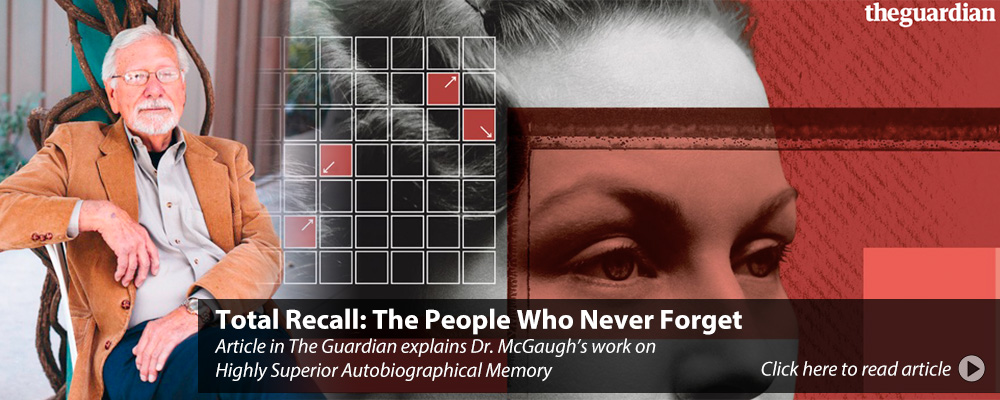Highly Superior Autobiographical Memory (HSAM) is a memory phenomenon first described by researchers at the Center for the Neurobiology of Learning and Memory at UC Irvine. Individuals with HSAM have a superior ability to recall specific details of autobiographical events, tend to spend a large amount of time thinking about their past and have a detailed understanding of the calendar and its patterns.
Initial Discovery: In 2006, Professor James McGaugh and colleagues reported the first known case of HSAM in a research participant known as “AJ”, later identified as Jill Price. When provided with a date, Jill could specify on which day of the week it fell and what she did that day. Since then, more individuals with this extraordinary ability have been identified (over 50 now), and CNLM researchers have been working to understand this mysterious ability. The condition was renamed to HSAM from its original label, hyperthymesia, which was used in the original report. Read all of the scientific reports here. The phenomenon and the work have been highlighted in numerous media venues.
Where we stand: So far, a number of other individuals have been identified with similar abilities and a number of other research groups have begun to explore this phenomenon. Memory for public events has typically been used as a screening criterion which is then followed by more rigorous memory testing. However, it is now clear that these tests rely heavily on expertise as well as the age of the participant. There is also a strong cultural bias in the questions typically asked.
Currently, we are developing new tools to probe this phenomenon that do not rely on individual expertise or explicit knowledge of public events. If you suspect you might have this ability, click here to take the screening.
So far, the studied conducted at UC Irvine suggest that individuals with HSAM have superior abilities in autobiographical memories but are no different from age- and sex-matched control participants on standard laboratory memory tests. Furthermore, MRI studies of their brain show preliminary evidence of specific regions and networks that may be different from control participants, although this is work that is still quite preliminary.
We have also identified several children with this ability, and are now conducting genetic studies in twins to understand the potential genetic basis of this ability. Genetic studies are conducted in collaboration with Dr. Rudy Tanzi's research group at Harvard. If you suspect that your child may have this ability, please fill out the screening.
SDAM: In 2015, the opposite memory phenotype was identified by colleagues at Baycrest's Rotman Research Institute in Toronto. Professor Brian Levine and colleagues described and named a condition known as Severely Deficient Autobiographical Memory (SDAM), which refers to a lifelong inability to vividly recollect or re-experience personal past events from a first-person perspective. We are now launching a collaboration with our colleagues at the Rotman to understand both extremes of autobiographical memory.
Research team at UCI: Several investigators at the CNLM, in collaboration with Dr. McGaugh, are working closely to understand the HSAM phenomenon and its underlying neural basis. Most notably, CNLM Director, Dr. Michael Yassa, and Dr. Craig Stark as well as members of their research teams.
Collaborators outside UCI: Collaborating teams with UCI investigators include Patrizia Campolongo at Sapienza Universita di Roma, Valerio Santangelo at University Degli Studi di Perugia, Roddy Roediger at Washington University in St. Louis, Aaron Mattfeld at Florida State University, and Rudi Tanzi and Jaehong Suh at Harvard University and Ruth Benca at UC Irvine.
Supporting the research: The study of HSAM could significantly inform on how the brain can optimize or enhance its processing of memories, knowledge which can be used to reverse engineer the process such that we can use it to prevent or treat memory disorders. However, this type of fundamental discovery process is rarely supported by federal funds. Click here to find out how you can support this research.

